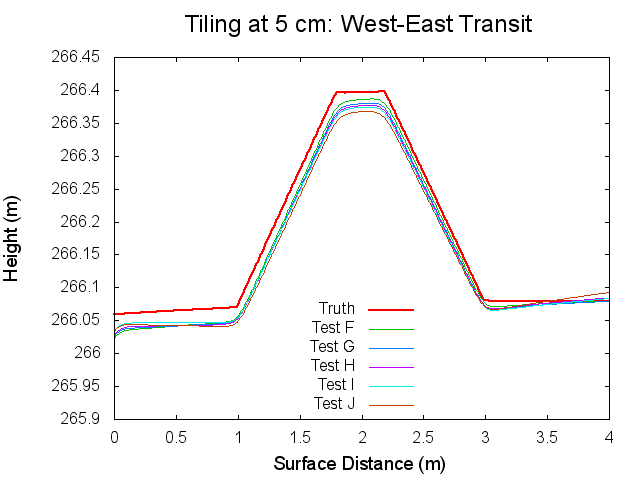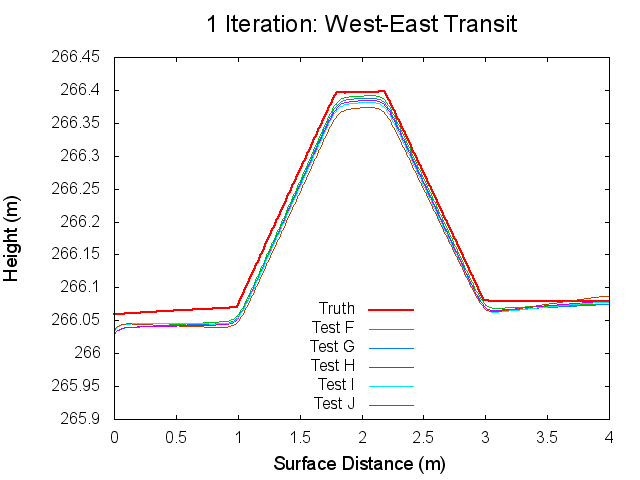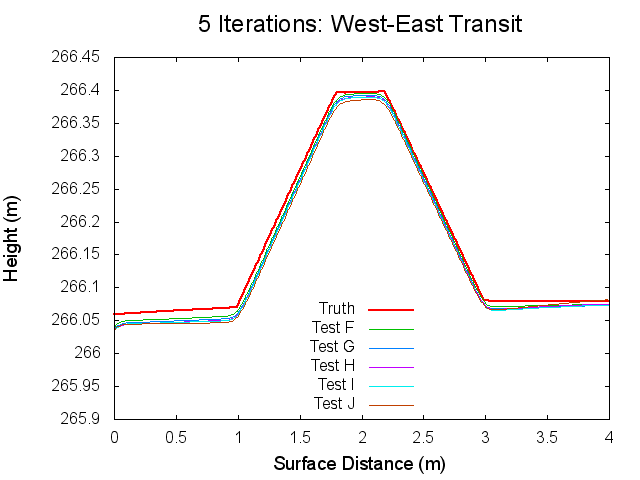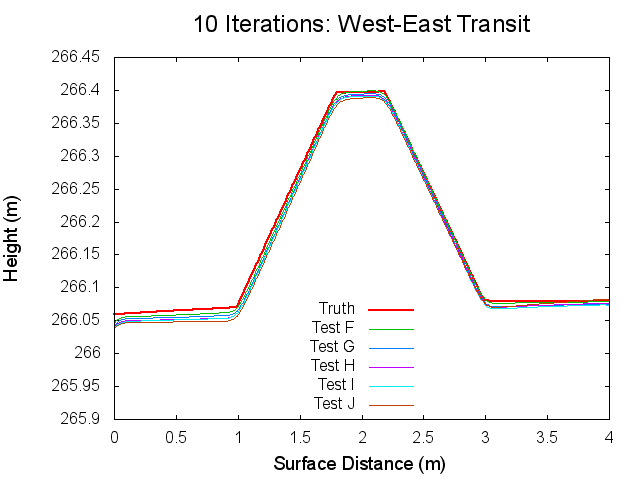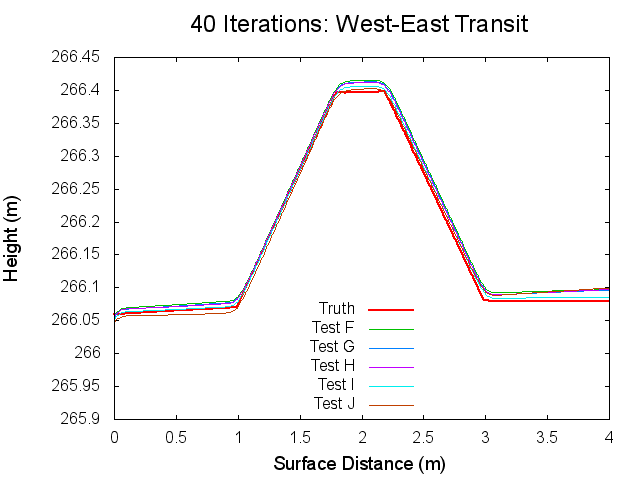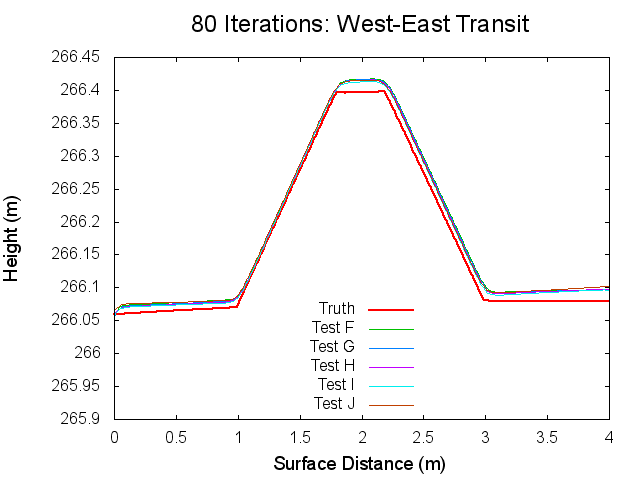|
Size: 4253
Comment:
|
Size: 4975
Comment:
|
| Deletions are marked like this. | Additions are marked like this. |
| Line 11: | Line 11: |
| '''Figure 2: CompareOBJ's Calculated RMS With Optimal Rot. & Trans.''' | Comparing the CompareOBJ RMS between the Azimuth Variation Tests yielded very interesting results because one can clearly see the minimum CompareOBJ calculated RMS values obtained for each test. Test F has the lowest RMS minimum with it occurring the earliest and Test J has the greatest RMS with it occurring the latest. Furthermore, the other tests see to follow this trend where better azimuthal representation correlates to a lower CompareOBJ RMS minimum that occurs earlier while worse azimuthal representation correlates to a greater CompareOBJ RMS minimum that occurs later. |
| Line 13: | Line 13: |
| '''Figure 3: CompMapVec's Calculated RMS''' | '''Figure 2: CompareOBJ's Calculated RMS Minimum Occurrence''' {{attachment:MinOccurance.png||width="800"}} '''Figure 3: CompareOBJ's Calculated RMS Minimum Value {{attachment:MinValue.png||width="800"}} '''Figure 4: CompareOBJ's Calculated RMS With Optimal Rot. & Trans.''' '''Figure 5: CompMapVec's Calculated RMS''' |
| Line 17: | Line 27: |
| '''Figure 4: Measured Formal Uncertainty''' | '''Figure 6: Measured Formal Uncertainty''' |
| Line 21: | Line 31: |
| The observation that sticks out the most when comparing the formal uncertainty between the Azimuth Variations Tests is that at higher iterations the formal uncertainties for Tests G, H, I, and J seem to be hovering around one another while the formal uncertainty for Test F about 1 cm greater than the formal uncertainty for all the other Azimuth Variation Tests. By looking at figure 1, one will also notice that CompareOBJ's calculated RMS for Test F is also the highest CompareOBJ calculated RMS for all the Azimuth Variation Tests at relatively higher ( more than 30) iterations. This is interesting because Figure 3 shows CompMapVec's calculated RMS for Test F to be one of the lowest CompMapVec calculated RMS values out of all the other Azimuth Variation Tests throughout the iterative Process. Thus, I do not think Figure 1 and Figure 3 can explain why Test F's formal uncertainty is so much than the formal uncertainty from all the other Azimuth Variation Tests at higher iterations when the RMS trend of those graphs are analyzed at the higher iterations. | The observation that sticks out the most when comparing the formal uncertainty between the Azimuth Variations Tests is that at higher iterations the formal uncertainties for Tests G, H, I, and J seem to be hovering around one another while the formal uncertainty for Test F is about 1 cm greater than the formal uncertainty for all the other Azimuth Variation Tests. By looking at figure 1, one will also notice that CompareOBJ's calculated RMS for Test F is also the highest CompareOBJ calculated at relatively higher ( more than 30) iterations. This is interesting because Figure 3 shows CompMapVec's calculated RMS for Test F to be one of the lowest CompMapVec calculated RMS values at higher iterations. Thus, I do not think Figure 1 and Figure 3 can explain why Test F's formal uncertainty is so much higher than the formal uncertainty from all the other Azimuth Variation Tests at higher iterations when the RMS trend of those Tests are analyzed at higher iterations. |
| Line 23: | Line 33: |
| However, going back to the observations from Figure 1, it would seem that the minimum CompareOBJ RMS of Test F being the lowest and occurring the earliest my be able to explain why Test F's formal uncertainty is the at higher iterations. Also, Figure 2 shows Test F's CompMapVec RMS to be the lowest at lower at iterations. Therefore, it appears that when the CompMapVec RMS and CompareOBJ are low relatively low, the formal uncertainty will be relatively high at greater iterations. The conclusion just made though will only occur when image azimuthal representation better than some factor. From Figure 4, it appears that at that specific azimuthal representation factor, the formal uncertainty starts to be distinctly greater than when less azimuthal representation is present. Thus, it appears the azimuthal representation where the formal uncertainty is a lot greater is somewhere between every 30 degrees (Test G) and every 20 degrees (Test F). | However, going back to the observations from Figure 1, it would seem that the minimum CompareOBJ RMS of Test F being the lowest and occurring the earliest my be able to explain why Test F's formal uncertainty is the greatest at greater iterations. Also, Figure 2 shows Test F's CompMapVec RMS to be the lowest at lower at iterations. Therefore, it appears that when the CompMapVec RMS and CompareOBJ RMS are relatively low, the formal uncertainty will be relatively high at greater iterations. The conclusion just made though will only occur when image azimuthal representation is better than some factor. From Figure 4, it appears that at that specific azimuthal representation factor, the formal uncertainty starts to be distinctly greater than when less azimuthal representation is present. Thus, it appears the azimuthal representation where the formal uncertainty is a lot greater is somewhere between every 30 degrees (Test G) and every 20 degrees (Test F). |
| Line 29: | Line 39: |
| '''Figures 5 through 10: North to South Traces of F/G/H/I/J Tests at various iterations''' | '''Figures 7 through 12: North to South Traces of F/G/H/I/J Tests at various iterations''' |
| Line 42: | Line 52: |
| '''Figures 11 through 16: West to East Traces of F/G/H/I/J Tests at various iterations''' | '''Figures 12 through 17: West to East Traces of F/G/H/I/J Tests at various iterations''' |
Test Over11 F/G/H/I/J Comparative Results
Line Graphs
The following two figures are line graphs that show measurements of CompareOBJ's calculated RMS with and without optimal rotation & translation at each iteration. Furthermore, figures 3 and 4 show CompMapVec's calculated RMS and the measured formal uncertainty at each iteration respectfully. A discussion of the observations are discussed below each figure. Note that iteration "0" is the tiling at 5 cm step.
Figure 1: CompareOBJ's Calculated RMS
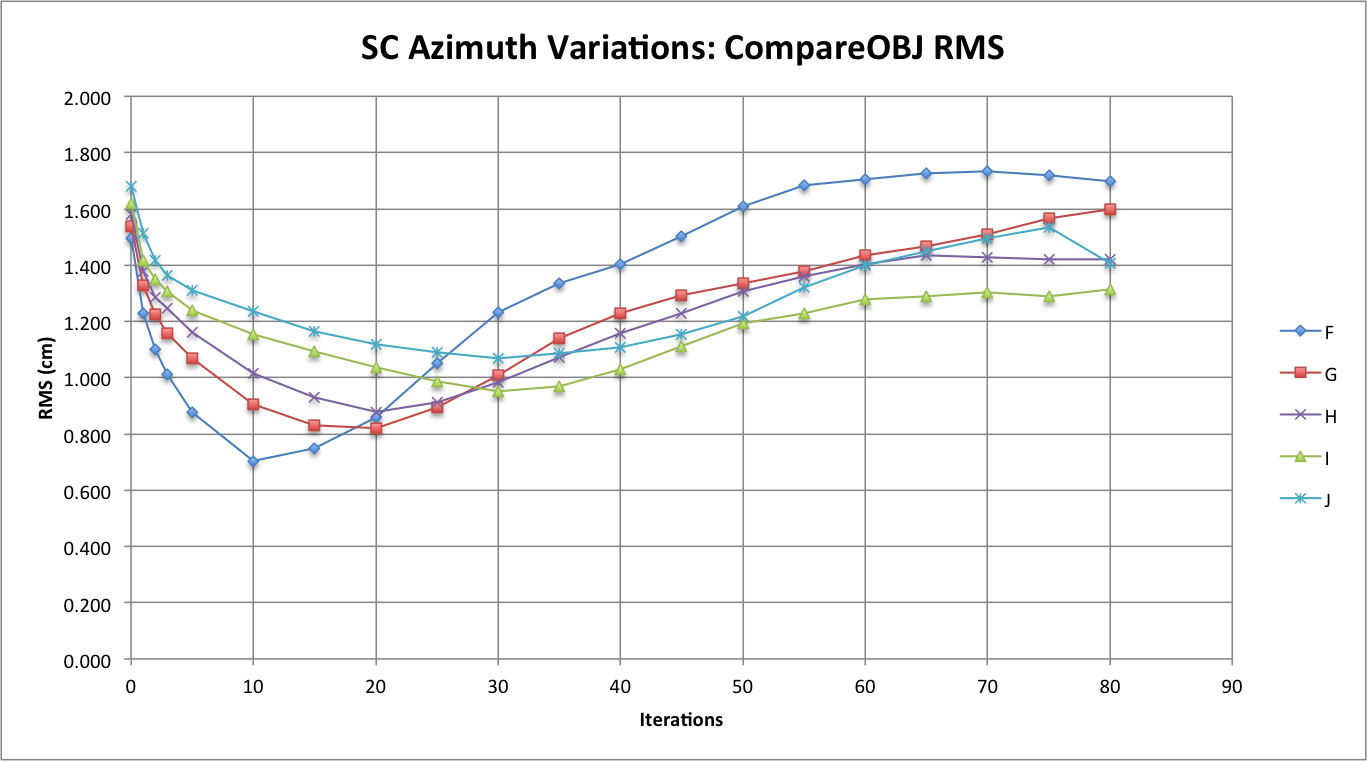
Comparing the CompareOBJ RMS between the Azimuth Variation Tests yielded very interesting results because one can clearly see the minimum CompareOBJ calculated RMS values obtained for each test. Test F has the lowest RMS minimum with it occurring the earliest and Test J has the greatest RMS with it occurring the latest. Furthermore, the other tests see to follow this trend where better azimuthal representation correlates to a lower CompareOBJ RMS minimum that occurs earlier while worse azimuthal representation correlates to a greater CompareOBJ RMS minimum that occurs later.
Figure 2: CompareOBJ's Calculated RMS Minimum Occurrence
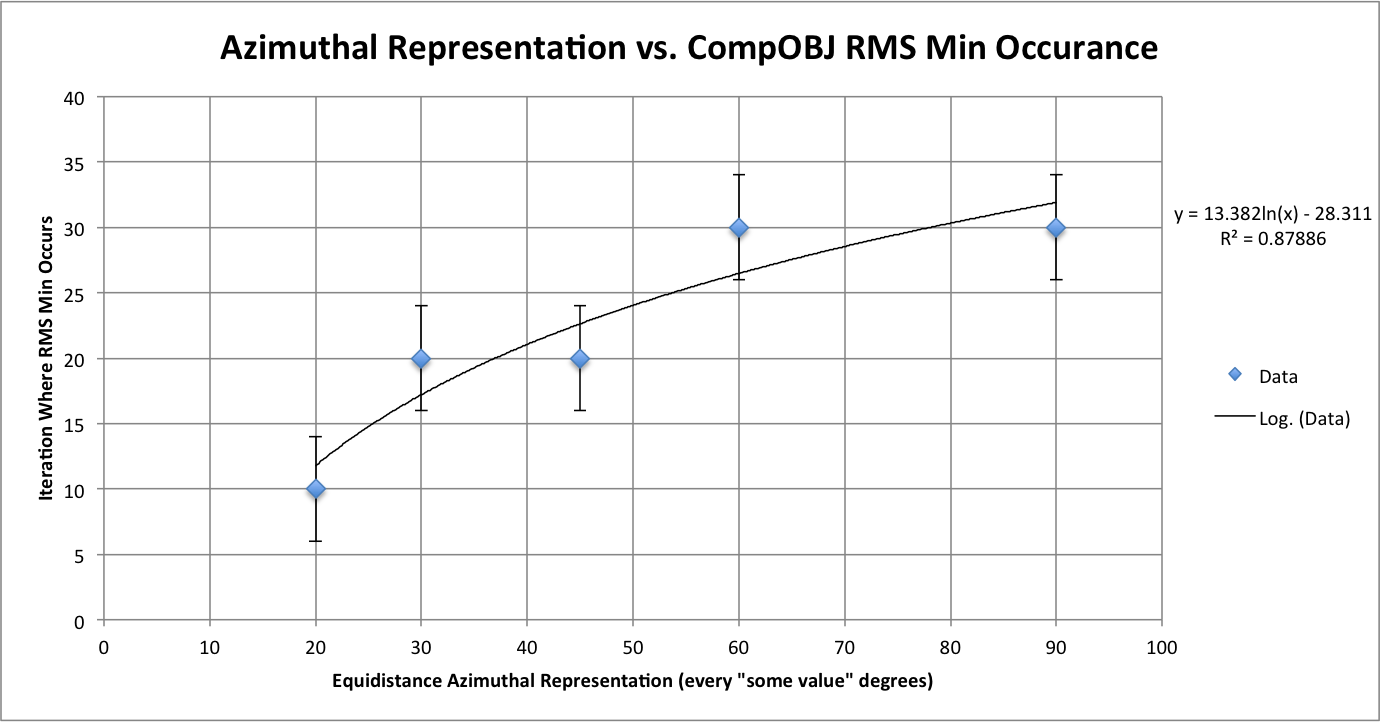
Figure 3: CompareOBJ's Calculated RMS Minimum Value The observation that sticks out the most when comparing the formal uncertainty between the Azimuth Variations Tests is that at higher iterations the formal uncertainties for Tests G, H, I, and J seem to be hovering around one another while the formal uncertainty for Test F is about 1 cm greater than the formal uncertainty for all the other Azimuth Variation Tests. By looking at figure 1, one will also notice that CompareOBJ's calculated RMS for Test F is also the highest CompareOBJ calculated at relatively higher ( more than 30) iterations. This is interesting because Figure 3 shows CompMapVec's calculated RMS for Test F to be one of the lowest CompMapVec calculated RMS values at higher iterations. Thus, I do not think Figure 1 and Figure 3 can explain why Test F's formal uncertainty is so much higher than the formal uncertainty from all the other Azimuth Variation Tests at higher iterations when the RMS trend of those Tests are analyzed at higher iterations. However, going back to the observations from Figure 1, it would seem that the minimum CompareOBJ RMS of Test F being the lowest and occurring the earliest my be able to explain why Test F's formal uncertainty is the greatest at greater iterations. Also, Figure 2 shows Test F's CompMapVec RMS to be the lowest at lower at iterations. Therefore, it appears that when the CompMapVec RMS and CompareOBJ RMS are relatively low, the formal uncertainty will be relatively high at greater iterations. The conclusion just made though will only occur when image azimuthal representation is better than some factor. From Figure 4, it appears that at that specific azimuthal representation factor, the formal uncertainty starts to be distinctly greater than when less azimuthal representation is present. Thus, it appears the azimuthal representation where the formal uncertainty is a lot greater is somewhere between every 30 degrees (Test G) and every 20 degrees (Test F).
The following figures are topographical transits of the test bigmaps through the center (North to South) at various iterations throughout the SPC process.
The following figures are topographical transits of the test bigmaps through the center (West to East) at various iterations throughout the SPC process. 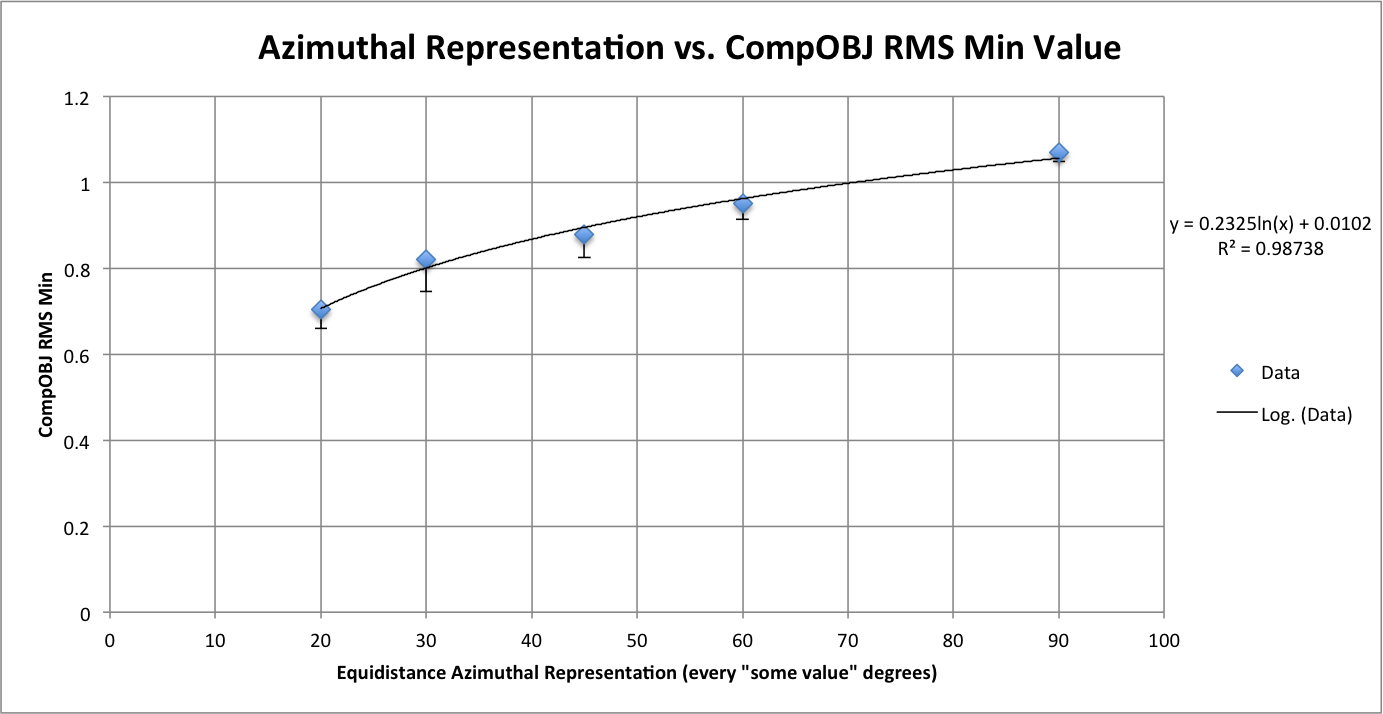
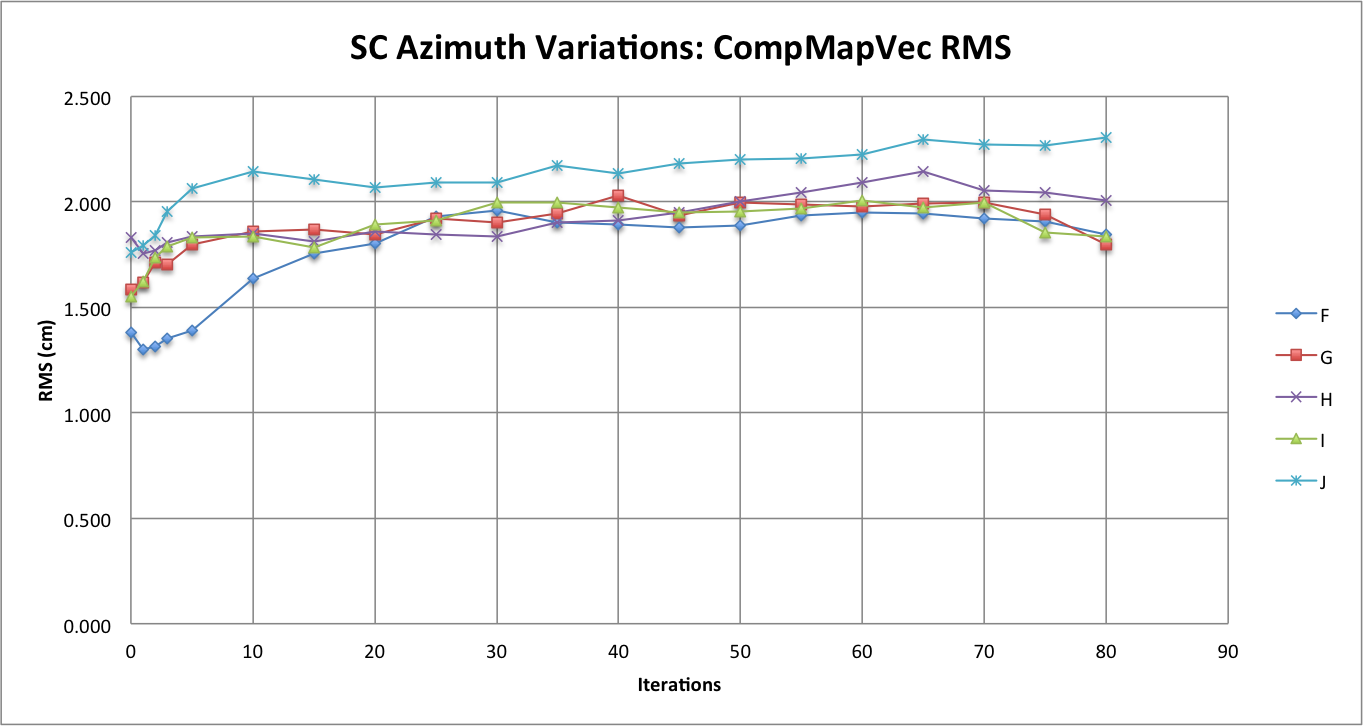

Traces: North to South
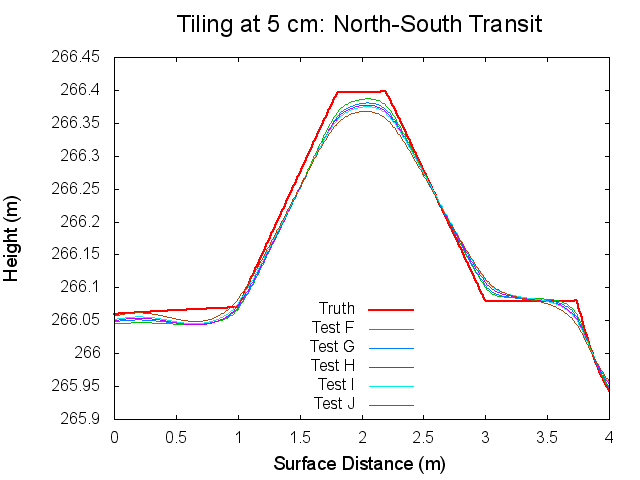
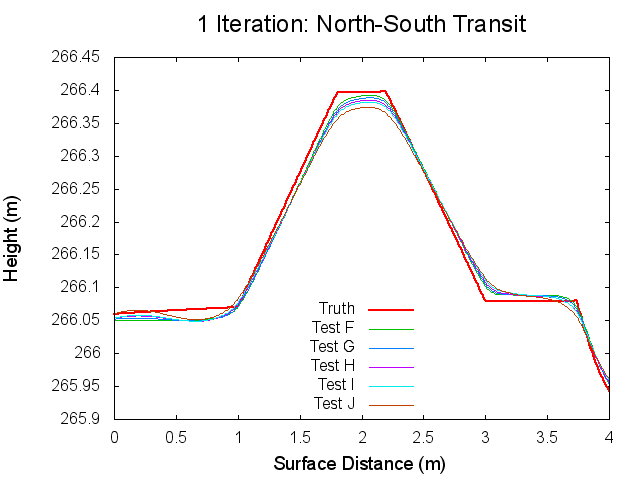
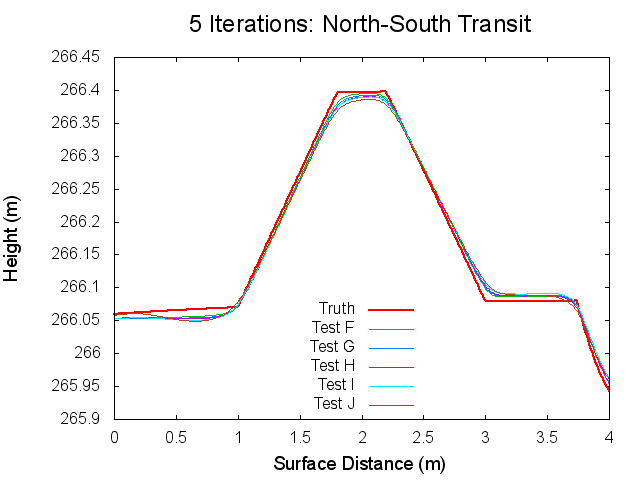
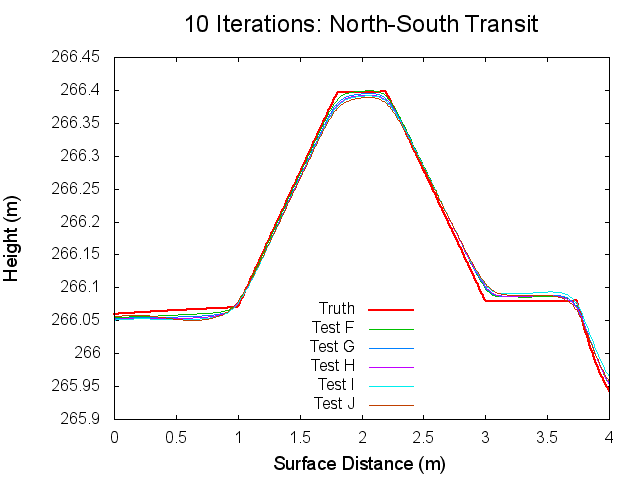
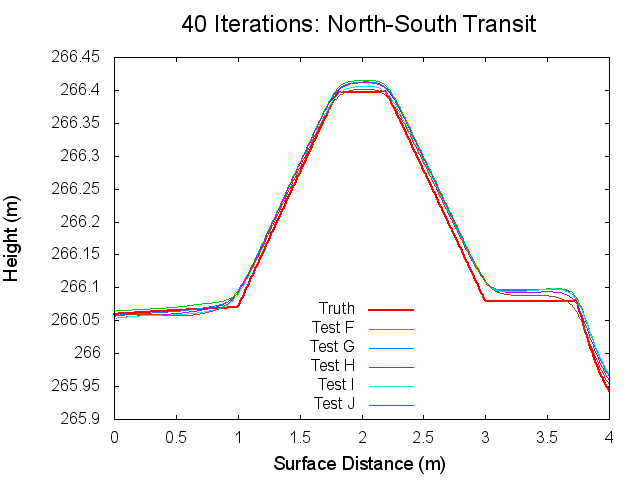
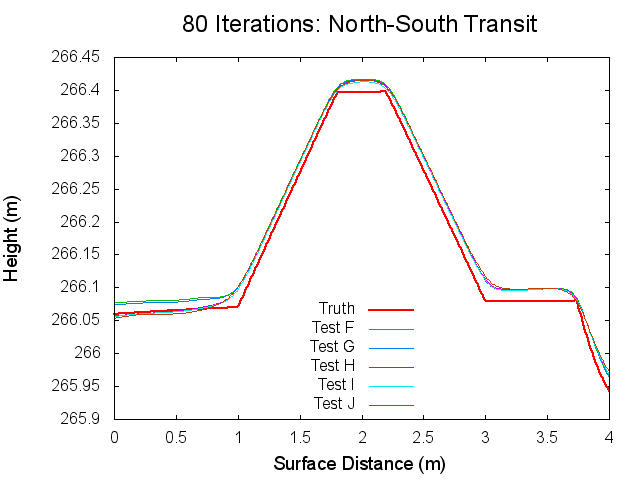
Traces: West to East
